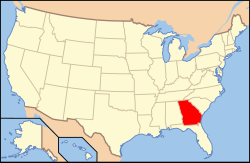| Wine region | |
 | |
| Official name | State of Georgia |
|---|---|
| Type | U.S. State Appellation[1] |
| Years of wine industry | 236 |
| Country | United States |
| Sub-regions | Dahlonega Plateau AVA, Upper Hiwassee Highlands AVA |
| Climate region | Region I-IV[2][3] |
| Total area | 59,411 square miles (38,023,040 acres) |
| Grapes produced | Albariño, Cabernet Franc, Cabernet Sauvignon, Carlos, Catawba, Cayuga, Chambourcin, Chardonel, Chardonnay, Concord, De Chaunac, Gewürztraminer, Malbec, Marsanne, Merlot, Mourvedre, Muscadine, Niagara, Noble, Norton, Petit Manseng, Pinot blanc, Pinot gris, Pinot noir, Riesling, Roussanne, Sangiovese, Scarlet, Scuppernong, Seyval blanc, Syrah, Tannat, Touriga Nacional, Vidal blanc, Viognier[1] |
Georgia wine refers to wine made from grapes grown in the U.S. state of Georgia. Georgia was an important winegrowing region of the United States in the 19th century, and by 1900 ranked sixth in production among U.S. states.
The state of Georgia first prohibited alcoholic beverages before many other states, in 1907 and subsequently the Georgian wine industry was decimated by Prohibition in the United States. The modern wine industry of Georgia only began in the 1980s. Georgia is the national leader in the production of wine from the Muscadine grape.[1]
In 2014, the multi-state Upper Hiwassee Highlands AVA, which encompasses three counties in northwestern Georgia and across the border into two counties in southwestern North Carolina toward the Tennessee border, was recognized as the state's first viticultural area. Four years later, Georgia's second AVA, Dahlonega Plateau was formally established further south in the foothills of the Three Sisters Mountain.
- ^ a b c "Georgia: Appellation Profile". Appellation America. 2007. Archived from the original on April 6, 2015. Retrieved November 27, 2007.
- ^ "Proposed Establishment of the Upper Hiwassee Highlands Viticultural Area" (27 CFR Part 9 [Docket No. TTB–2013–0008: Notice No. 139] RIN 1513–AC02 Proposed Rule). Federal Register. 78 (134). Alcohol and Tobacco Tax and Trade Bureau (TTB), Treasury: 41891–41898. July 12, 2013.
 This article incorporates text from this source, which is in the public domain.
This article incorporates text from this source, which is in the public domain.
- ^ "Proposed Establishment of the Dahlonega Plateau Viticultural Area" (27 CFR Part 9 [Docket No. TTB–2016–0012; Notice No. 166] RIN 1513–AC33 Proposed). Federal Register. 81 (232). Alcohol and Tobacco Tax and Trade Bureau (TTB), Treasury: 86980–86987. December 2, 2016.
 This article incorporates text from this source, which is in the public domain.
This article incorporates text from this source, which is in the public domain.